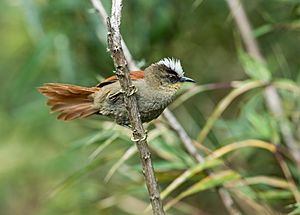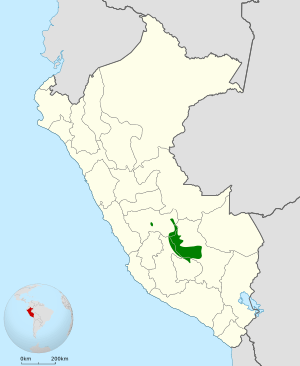Vilcabamba spinetail facts for kids
Quick facts for kids Vilcabamba spinetail |
|
|---|---|
 |
|
| Conservation status | |
| Scientific classification | |
| Genus: |
Cranioleuca
|
| Species: |
weskei
|
 |
|
| Synonyms | |
|
Cranioleuca marcapatae weskei |
|
The Vilcabamba spinetail (scientific name: Cranioleuca weskei) is a small bird that lives only in Peru. It belongs to a bird family called Furnariidae, which are often known as ovenbirds. This special bird was first discovered in 1984.
Scientists first thought the Vilcabamba spinetail was just a type of subspecies of another bird, the Marcapata spinetail. A subspecies is like a different version of a species. But later, more research showed it was unique enough to be its own separate species. This means it has its own special features that make it different from other birds.
Contents
What is the Vilcabamba Spinetail?
The Vilcabamba spinetail is a small songbird. It gets its name from the Vilcabamba mountain range in Peru, where it lives. These birds are known for their long, stiff tail feathers, which look a bit like spines.
Where Does This Bird Live?
This bird is endemic to Peru. This means it is found naturally nowhere else in the world. It lives in the high mountains of Peru, specifically in the Vilcabamba mountain range.
What is its Natural Home?
The Vilcabamba spinetail's natural habitat is in moist montane forest. This means it lives in forests found on mountainsides. These forests are often wet and misty, with lots of trees and plants. They are usually found at high elevations, where the air is cooler.
Discovery and Classification
The Vilcabamba spinetail was officially described as a new species in 1984 by a scientist named James Van Remsen Jr.. When a new animal is found, scientists give it a unique name. This helps everyone know exactly which animal they are talking about.
How Do Scientists Classify Birds?
Scientists group living things based on how they are related. They use a system that goes from very broad groups to very specific ones. For example, all birds are in a large group. Then, they are divided into families, like the Furnariidae family for the spinetail. Finally, they are grouped into a specific species, like the Vilcabamba spinetail.
Why Was it Thought to be a Subspecies?
When scientists first studied the Vilcabamba spinetail, they noticed it was very similar to the Marcapata spinetail. Because of these similarities, they first thought it was just a subspecies. However, after more detailed studies, they found enough differences to call it a completely separate species. This often happens as scientists learn more about animals.
Conservation Status
The Vilcabamba spinetail is currently listed as "Least Concern" by the IUCN (International Union for Conservation of Nature). This means that its population is stable and it is not currently at high risk of disappearing. However, it is always important to protect the places where these unique birds live.
Protecting Mountain Forests
The moist montane forests where the Vilcabamba spinetail lives are very important. These forests are home to many different kinds of plants and animals. Protecting these habitats helps not only the spinetail but also many other species that depend on them.
Images for kids
See also
 In Spanish: Curutié de Vilcabamba para niños
In Spanish: Curutié de Vilcabamba para niños




